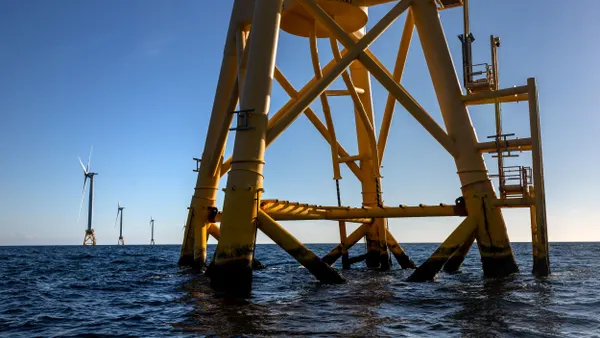Dive Brief:
- After more than 40 years of wind energy buildout, Wood Mackenzie projects that global capacity will hit 1 TW this year before doubling to 2 TW in the next 8 years, which one clean energy official says highlights the need for rapid expansion of transmission and grid interconnection.
- The consulting firm’s market outlook, published Tuesday, says that offshore wind alone “will experience sevenfold growth by 2032 and account for a 26% share of total capacity over the ten-year outlook.”
- “Transmission is often sort of this afterthought in our focus on prioritizing and incentivizing clean energy generation, but it really needs to now be a forefront of our focus, because transmission takes a long time to build, and without it, we won't be able to get these resources online,” Caitlin Marquis, managing director of Advanced Energy United, said in an interview.
Dive Insight:
“There's a recent Princeton study that found that achieving the greenhouse gas reduction potential of the [Inflation Reduction Act] would require more than doubling the historic pace of transmission buildout that we've seen over the past decade,” said Marquis.
Wood Mackenzie projects that China’s wind power market will have a strong rebound in 2023 after suffering due to the country’s lockdown policy, and that the U.S. will experience a similar rebound once the Treasury Department publishes eligibility guidance for the IRA’s renewable energy tax credit provisions.
“With policy clarity, approval and investment in transmission projects, and development of the offshore market’s nascent supply chain, annual additions [of U.S. wind power] will intensify and average 20 GW per year from 2026 through 2032,” said Wood Mackenzie research director Luke Lewandowski in a news release.
Marquis said that states as well as the federal government need to make transmission buildout a top priority. There are a number of actions the federal government is taking on transmission, she said, but the complicated and multi-pronged nature of the effort requires constant forward movement by all involved entities.
While the Federal Energy Regulatory Commission weighs proposals to reform transmission and interconnection planning, the amount of new energy capacity trapped in interconnection queues while waiting to be connected to the grid continues to grow, with one Department of Energy laboratory estimating 95% of that queued energy is renewable energy.
In a February interview, Advanced Energy United’s transmission campaign director Verna Mandez said a “lack of precedent and poorly defined decision-making authority” might be two of the biggest threats to transmission build-out.
“These are also very long processes,” Marquis said. “There are multiple challenges to getting transmission built – there's the planning process that needs to be improved, there's the siting and permitting process, there's cost allocation.”
In the U.S., the federal government has established an offshore wind goal of 30 GW by 2030, while the goals of 11 coastal states exceed 50 GW through 2035 and reach 77 GW by 2045.
Close to 200 GW of offshore wind might be required by 2050 to meet the decarbonization goals of individual states, and proactive transmission planning could save up to $20 billion on the cost of deploying offshore wind over the next few decade, said a January report from consulting firm Brattle Group.
“These resources are increasingly affordable, they're available, they're reliable, but there are other roadblocks to getting them operational and delivering electricity,” Marquis said. “Increasingly, given the competitiveness and availability of these resources, getting the grid ready for them is where policymakers need to be paying more attention than they have in the past.















